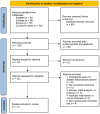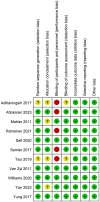Comparison of balanced crystalloids versus normal saline in patients with diabetic ketoacidosis: a meta-analysis of randomized controlled trials
- PMID: 38836222
- PMCID: PMC11148269
- DOI: 10.3389/fendo.2024.1367916
Comparison of balanced crystalloids versus normal saline in patients with diabetic ketoacidosis: a meta-analysis of randomized controlled trials
Abstract
Purpose: The optimal resuscitative fluid for patients with diabetic ketoacidosis (DKA) remains controversial. Therefore, our objective was to assess the effect of balanced crystalloids in contrast to normal saline on clinical outcomes among patients with DKA.
Methods: We searched electronic databases for randomized controlled trials comparing balanced crystalloids versus normal saline in patients with DKA, the search period was from inception through October 20th, 2023. The outcomes were the time to resolution of DKA, major adverse kidney events, post-resuscitation chloride, and incidence of hypokalemia.
Results: Our meta-analysis encompassed 11 trials, incorporating a total of 753 patients with DKA. There was no significant difference between balanced crystalloids and normal saline group for the time to resolution of DKA (MD -1.49, 95%CI -4.29 to 1.31, P=0.30, I2 = 65%), major adverse kidney events (RR 0.88, 95%CI 0.58 to 1.34, P=0.56, I2 = 0%), and incidence of hypokalemia (RR 0.80, 95%CI 0.43 to 1.46, P=0.46, I2 = 56%). However, there was a significant reduction in the post-resuscitation chloride (MD -3.16, 95%CI -5.82 to -0.49, P=0.02, I2 = 73%) among patients received balanced crystalloids.
Conclusion: Among patients with DKA, the use of balanced crystalloids as compared to normal saline has no effect on the time to resolution of DKA, major adverse kidney events, and incidence of hypokalemia. However, the use of balanced crystalloids could reduce the post-resuscitation chloride.
Systematic review registration: https://osf.io, identifier c8f3d.
Keywords: balanced crystalloids; diabetic ketoacidosis; meta-analysis; normal saline; resuscitation.
Copyright © 2024 Liu, Zhang, Xu and Zou.
Conflict of interest statement
The authors declare that the research was conducted in the absence of any commercial or financial relationships that could be construed as a potential conflict of interest.
Figures






Similar articles
-
Clinical Effects of Balanced Crystalloids vs Saline in Adults With Diabetic Ketoacidosis: A Subgroup Analysis of Cluster Randomized Clinical Trials.JAMA Netw Open. 2020 Nov 2;3(11):e2024596. doi: 10.1001/jamanetworkopen.2020.24596. JAMA Netw Open. 2020. PMID: 33196806 Free PMC article. Clinical Trial.
-
Balanced crystalloids versus saline in critically ill patients: The PRISMA study of a meta-analysis.Medicine (Baltimore). 2021 Sep 24;100(38):e27203. doi: 10.1097/MD.0000000000027203. Medicine (Baltimore). 2021. PMID: 34559108 Free PMC article.
-
Balanced Crystalloids Versus Saline in Critically Ill Adults: A Systematic Review and Meta-analysis.Ann Pharmacother. 2020 Jan;54(1):5-13. doi: 10.1177/1060028019866420. Epub 2019 Jul 31. Ann Pharmacother. 2020. PMID: 31364382
-
Balanced Crystalloids Versus Normal Saline in Kidney Transplant Patients: An Updated Systematic Review, Meta-analysis, and Trial Sequential Analysis.Anesth Analg. 2024 Jul 1;139(1):58-67. doi: 10.1213/ANE.0000000000006932. Epub 2024 Apr 5. Anesth Analg. 2024. PMID: 38578867
-
Balanced crystalloids versus normal saline for fluid resuscitation in critically ill patients: A systematic review and meta-analysis with trial sequential analysis.Am J Emerg Med. 2019 Nov;37(11):2072-2078. doi: 10.1016/j.ajem.2019.02.045. Epub 2019 Mar 1. Am J Emerg Med. 2019. PMID: 30852043
Cited by
-
Effectiveness of Balanced Electrolyte Solution vs Normal Saline in the Resuscitation of Adult Patients with Diabetic Ketoacidosis: An Updated Systematic Review and Meta-analysis.Indian J Crit Care Med. 2025 Jan;29(1):65-74. doi: 10.5005/jp-journals-10071-24861. Epub 2024 Dec 30. Indian J Crit Care Med. 2025. PMID: 39802248 Free PMC article.
References
Publication types
MeSH terms
Substances
LinkOut - more resources
Full Text Sources

